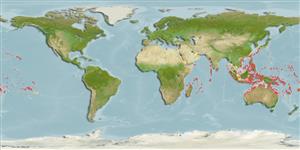Classification / Names
Common names from other countries
Main reference
Size / Weight / Age
Max length : 10.0 cm TL male/unsexed; (Ref. 4391); common length : 6.0 cm TL male/unsexed; (Ref. 5450); max. reported age: 6 years (Ref. 72479)
Length at first maturity
Lm 5.0 range ? - ? cm
Environment
Marine; reef-associated; non-migratory; depth range 0 - 20 m (Ref. 9710)
Climate / Range
Tropical, preferred ?; 38°N - 35°S, 19°E - 124°W
Distribution
Indo-West Pacific: Red Sea and East Africa to the Line, Marquesan and Tuamoto islands, north to southern Japan, south to Sydney, Australia.
Countries | FAO areas | Ecosystems | Occurrences | Introductions
Short description
Dorsal
spines
(total): 12;
Dorsal
soft rays
(total): 11-13;
Anal
spines: 2;
Anal
soft rays: 11 - 13. Color in life white with 3 black bars; a large brown spot on dorsal part of snout and interorbital; lips dusky or white; caudal fin pale; pelvic fins black; pectorals transparent. Margins of preorbital, suborbital, and preoperculum finely serrated (Ref. 2746). Body depth 1.5-1.7 in SL (Ref. 90102).
IUCN Red List Status (Ref. 115185)
Threat to humans
Harmless
Human uses
Fisheries: of no interest; aquarium: commercial
Tools
Special reports
Download XML
Internet sources
Estimates of some properties based on models
Phylogenetic diversity index
PD50 = 0.5010 many relatives (e.g. carps) 0.5 - 2.0 few relatives (e.g. lungfishes)
Trophic Level
3.3 ±0.42 se; Based on food items.
Resilience
Medium, minimum population doubling time 1.4 - 4.4 years (tmax=6; Fec=1,500-2,000)
Vulnerability
Low to moderate vulnerability (26 of 100)
Price category
